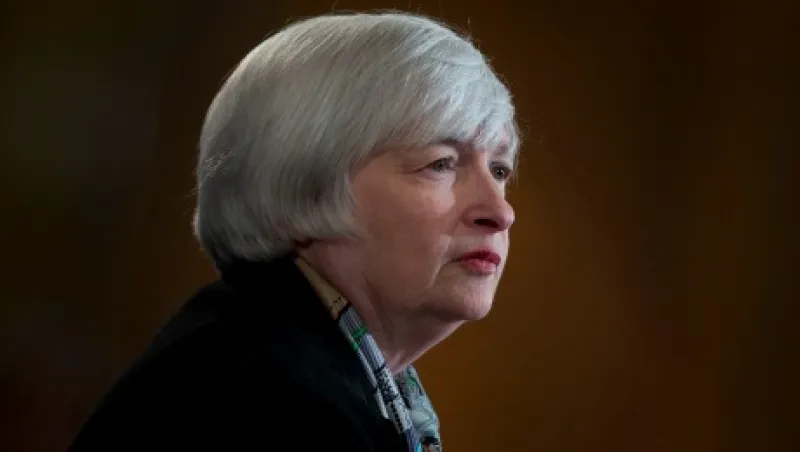The single biggest risk narrative for markets today hinges on a single word: considerable. When the Federal Open Market Committee announces its latest monetary policy at 2:00 pm U.S. Eastern this afternoon, investors will be looking intently for any shift in the language of the statement from the present dictum “considerable amount of time” that accommodative rates will remain in place. With growing signals of dissent within the Federal Reserve itself, the prospect that rates could rise sooner than most forecasters initially estimated is hanging over U.S. bond markets as investors eye the exit door.
Across the pond, the Bank of England released more new information about the state of the U.K. economy, with Monetary Policy Committee minutes from the last meeting showing that seven of the nine committee members voted to keep interest rates at an ultra-low 0.5 percent. U.K. unemployment dropped to 6.2 percent during the three-month period ended July, compared with February to April, according to the U.K. Office for National Statistics. During the latest period, wages in the country rose 0.7 percent, the weakest reading since 2001.
U.S. is harvesting a bumper corn crop. With only 4 percent of the total crop harvested to date, the latest reports from the U.S. Department of Agriculture reports indicate a record year for U.S. corn production. The department estimates the total harvest will exceed 14 billion bushels.
PBOC takes action. Media reports today indicated a new targeted liquidity action by the People’s Bank of China, the country’s central bank, that will see up to 500 billion yuan ($81.2 billion) passing into the banking system. The fresh capital, in the form of three-month loans, will reportedly be placed with the five largest banks in the nation in tranches of 100 billion yuan. In light of the slowdown in recent economic activity indicators, any move from Beijing to stimulate liquidity in short-term credit market stands to be a bullish signal for Chinese risk assets.
Deflation fears in Europe abate — somewhat. August consumer inflation levels for the euro zone released today by Eurostat registered slightly higher than consensus forecasts with the headline index expanding by a seasonally adjusted annualized 0.4 percent. Despite the marginal beat, price growth remains at multiyear lows and well below the European Central Bank’s target of just below 2 percent despite the two accommodative actions taken by the central bank this summer.
FedEx is delivering results. Memphis–based FedEx Corp. is scheduled to release first fiscal quarter earnings today. In the prior quarter, the company’s headline revenue grew 4 percent year-over-year to $11.4 billion on gains in the ground and freight segments. The overnight carrier’s report is often seen as an indicator for overall U.S. consumer and business activity, as well as for segments such as e-commerce.
Portfolio Perspective: In Defense of Active Management — Jason DeSena Trennert, Strategas Research Partners
While the claims that active investment is dead haven’t reached the status of BusinessWeek’s “Death of Equities” August 1979 cover story, such calls are being repeated more frequently and at higher decibel levels. In the July/August 2014 issue of Financial Analysts Journal, Charles Ellis, the founder of research firm Greenwich Associates, published what was tantamount to an obituary for the money management industry. The Wall Street Journal has highlighted the penchant of individual investors to eschew stock pickers in favor of indexation as well.
It is incumbent upon the dispassionate financial analyst to rejoice not in a rationalization of his chosen profession but in the truth. There is no question that the democratization and widespread diffusion of information and the sheer size of the money management industry has made it more difficult to add alpha. It should also be stated, however, that while indexation may look particularly attractive in a period of financial repression, when near-zero-percent interest rates dampen volatility and increase correlations, it is unlikely to appear as prudent in a period in which the invisible hand of free markets is able to assert itself. In short, betting on indexed funds to consistently outperform active money management requires, in part, an expectation that quantitative easing will never end. Such a conclusion would also suggest that the free enterprise system is superfluous. Despite what can sometimes appear to be a disposition suggesting otherwise, central bankers are not omniscient gods. It is in the turbulent times that the talented fund manager can most easily add alpha and prove his or her worth.
By our lights, the case for active over passive management rests on five basic pillars:
• The size of indexed assets may sow the seeds of its own lackluster performance;
• Higher interest rates and the end of financial repression will widen the differences between winners and losers;
• Low nominal growth environments create winner-take-all markets;
• More complex financial instruments and systems are likely to make markets less efficient than the academics would have you believe; and
• The prospects for peak profit margins and multiples in the next few years should benefit the skilled stock picker.
Jason DeSena Trennert is the managing partner of New York–based Strategas Research Partners and the chair and CEO of the firm’s broker-dealer subsidiary, Strategas Securities. This is an excerpt from an August research report.






